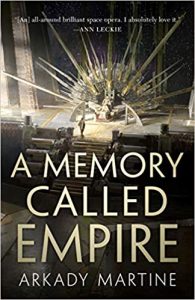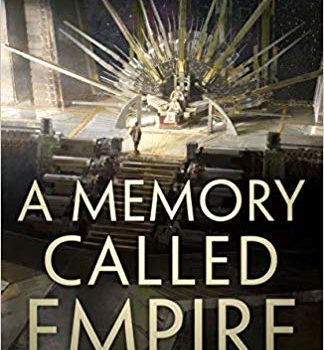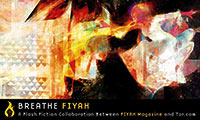Russell Letson Reviews A Memory Called Empire by Arkady Martine
 A Memory Called Empire, Arkady Martine (Tor 978-1-250-18643-0, $25.99, 462pp, hc) March 2019. Cover by Jaime Jones.
A Memory Called Empire, Arkady Martine (Tor 978-1-250-18643-0, $25.99, 462pp, hc) March 2019. Cover by Jaime Jones.
The byline on the cover of A Memory Called Empire, Arkady Martine, is the pen name of Dr. AnnaLinden Weller, a scholar of, among other things, the history of the Byzantine Empire. That is appropriate, since this first novel is all about the byzantine politics of an interstellar empire, as seen by a very new diplomat who finds herself immersed in mysteries and conspiracies while learning her trade on the fly. It’s also about several kinds of memory, but we’ll get to that later.
When the all-devouring Teixcalaan Empire requests a new ambassador from provincial, still-independent Lsel Station – actually, it’s more like “get somebody aboard the imperial cruiser right now” – the choice for the post is Mahit Dzamare, who is young and green but nevertheless a lifelong student and devotee of the Empire’s language, literature, and culture. Perhaps as important, she is also a good candidate to carry the imago – the recorded memories – of the previous ambassador, Yskander Aghavn, whose fate at the imperial court is not entirely clear. The imago resides in a device surgically implanted at the base of Mahit’s skull, and it is meant to supply her with her predecessor’s knowledge and expertise as a guide to her actions. Unfortunately, the imago is 15 years out of date, containing only the first five years’ worth of Yskander’s two decades of diplomatic experience, and Mahit has not had the usual adjustment period in which to absorb a secondary personality.
Mahit arrives on the Imperial capital world with no details of Yskander’s situation (“dead, compromised, or simply fallen prey to some internal imperial shakeup”) and little help from the incompletely integrated imago. Then the implant crashes or malfunctions, leaving Mahit with echoes and hints and whispers from the remnants of Yskander’s imago, but no coherent guidance on protocol or up-to-date information on his doings at court.
This is more than inconvenient, since in short order she discovers that Yskander was murdered, survives what appears to be an assassination attempt, and finds herself under house (well, maybe house-guest) arrest. What follows are glimpses of tensions in the imperial court and of the underbelly of Teixcalaani society, suspicions about covert activities on the part of factions back on Lsel Station, and lots of bouncing among imperial bureaucratic offices and court events. Mahit needs to not only discover but keep secrets – the existence and nature of Lsle’s imago technology. The fact that such technology is forbidden in the Empire does not mean that there aren’t parties who would like to get their hands on it.
Mahit also feels herself to be the country mouse, the provincial awash in the complexities and subtleties of an ancient and elaborate culture, even though she has spent her life fascinated by and immersed in Teixcalaani literature, music, and history. Despite that knowledge, she remains a “barbarian,” an outsider instantly recognizable as such by her height, appearance, and demeanor. On arrival at the imperial capital world-city, the City (the same word stands for the planet, the world-straddling megalopolis, and the empire), Mahit gets some help in the shape of liaison officer Three Seagrass and, later and quite unofficially, her friend Twelve Azalea, but she is otherwise on her own in her efforts to understand what became of her predecessor, what he might have been up to, and how he and Lsel Station fit into the machinations of the court and empire. (Teixcalaani naming conventions are a separate topic. Fortunately, there is a “Glossary of Persons, Places, and Objects” at the back of the book to help keep the names and details straight. Don’t be ashamed to use it.)
That’s the foreground, played out against a far-future background with strong echoes of C.J. Cherryh, Ann Leckie, and Ursula Le Guin: humankind spread across a respectable swath of the galaxy, hints of possible genetic divergence and of rise-and-fall cycles (where did the Teixcalaani come from?). Lsel Station is part of a culture based on habitats rather than planets, dependent on mining or trade, and spread across a frontier beyond which are both opportunities and possible threats. The Teixcalaan Empire recalls not only Byzantium, but also Imperial China: vast bureaucracy, aristocratic hierarchy (Three Seagrass is “patrician second-class”), elaborate literature, and a touch of xenophobia, or at least condescension toward outsiders and “barbarians.” There’s also more than a hint of pre-Columbian Meso-America in the language, the appearance of ethnic Teixcalaani, and the semiotics of Imperial political theater (particularly fossil remnants of blood sacrifice).
The title directs us to varieties of memory. Imago technology has been crucial to the stability of Lsel Station, since generations of expertise and wisdom are passed along in the stored memories. On the imperial side, there are the institutional memories that constitute a significant part of the empire’s identity. Teixcalaani have been telling themselves stories about themselves for generations, right back to their days as inhabitants of a single planet. These are encoded in their poetry and other literary forms – histories, romances, epics, movies, even public-service announcement in allusive verse – for example, The Buildings, “a seventeen-thousand-line poem which described the City’s architecture.” Mahit has absorbed – indeed, memorized – much of this in her pursuit of adopting a Teixcalaani identity, though she also realizes that she will never really belong in the way that the most ordinary born-and-bred imperial citizen does, reflexively and fully.
Behind the cloak-and-dagger maneuvers that drive the foreground action lies a consideration of the ways cultures maintain themselves and how individuals navigate “belonging” to such frameworks. It’s an absorbing and sometimes challenging blend of intrigue and anthropological imagination. (Use that Glossary.) It is also often quite funny, in a gentle and sneaky way. The title page does not announce this as the first of a series or trilogy, but I will be surprised and rather disappointed if there is not a sequel.
Russell Letson, Contributing Editor, is a not-quite-retired freelance writer living in St. Cloud, Minnesota. He has been loitering around the SF world since childhood and been writing about it since his long-ago grad school days. In between, he published a good bit of business-technology and music journalism. He is still working on a book about Hawaiian slack key guitar.
This review and more like it in the March 2019 issue of Locus.
 While you are here, please take a moment to support Locus with a one-time or recurring donation. We rely on reader donations to keep the magazine and site going, and would like to keep the site paywall free, but WE NEED YOUR FINANCIAL SUPPORT to continue quality coverage of the science fiction and fantasy field.
While you are here, please take a moment to support Locus with a one-time or recurring donation. We rely on reader donations to keep the magazine and site going, and would like to keep the site paywall free, but WE NEED YOUR FINANCIAL SUPPORT to continue quality coverage of the science fiction and fantasy field.








